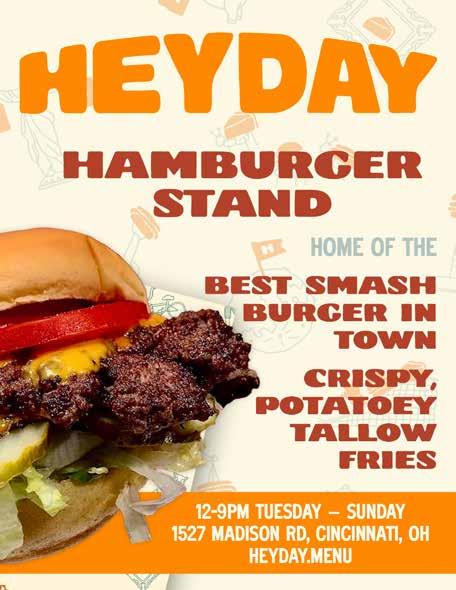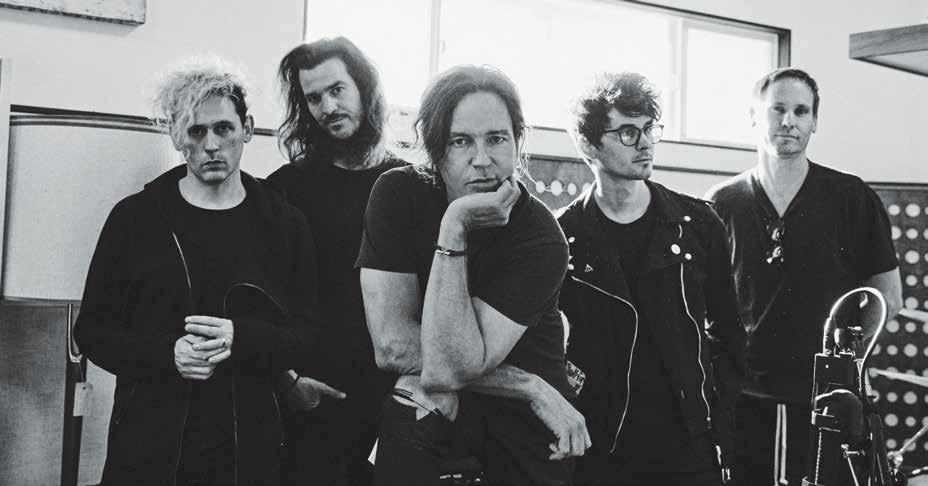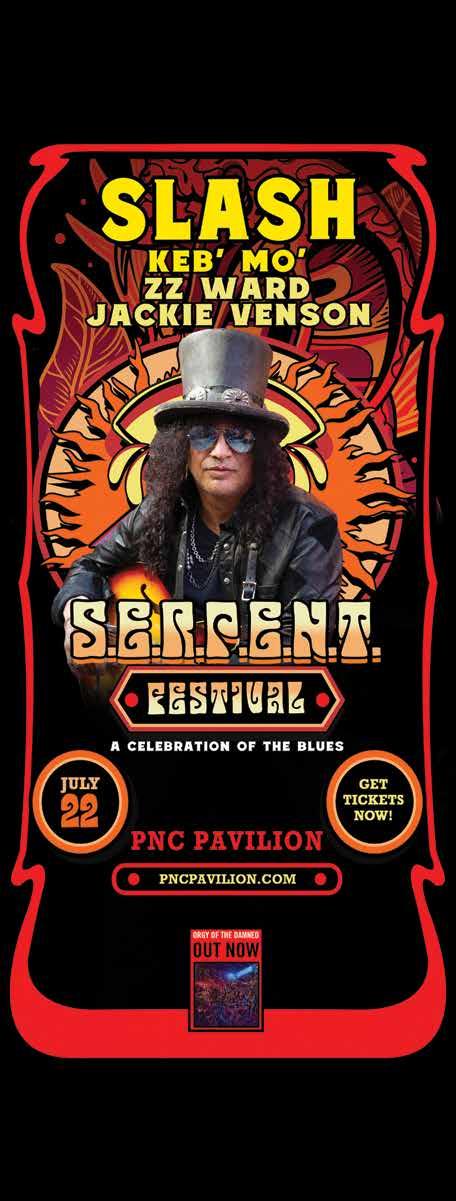


CONTRIBUTING





CONTRIBUTING


A civil rights attorney tells CityBeat that proving obstruction will be “a very high bar to get over” for the state.
BY MADELINE FENING
The man who recorded the nowviral arrest video that sparked backlash against the Cincinnati Police Department has been charged with obstruction, but a civil rights attorney tells CityBeat that it could be tough for the state to prove Eddie Lee’s actions interfered with CPD’s arrest.
Lee and his friend, Johnny Taylor, were among a group of people at the Government Square bus stop in downtown Cincinnati on June 1 when he said police approached and accused them of smoking weed.
“That’s what he said, ‘I can’t believe
the moments before the incident was requested and released by the Cincinnati Fraternal Order of Police (FOP) on Facebook, showing some individuals appearing to smoke, though it’s not explicitly clear what they are smoking; Taylor is seen opening a small package and removing what appears to be a cigar and a woman in a red dress appears to roll a joint. There’s also a man sitting on a bench who appears to combine alcohol with a mixer in a bottle.
Ken Kober, president of the FOP union, emphasized to CityBeat that more serious illegal activity is a problem at Government Square.
“There were 103 arrests that occurred at Government Square in 2023: 10 guns recovered, 62 offense reports, two homicides, five felonious assaults, shootings, seven robberies,” Kober said. “This has become a very, very violent area. Metro has poured hundreds of thousands of dollars into paying for outside employment for police officers to be there to combat these very crimes that are being committed.”
Lee told CityBeat the scene at the Government Square was peaceful before police got involved on June 1, but that it quickly grew tense when an officer approached Taylor. That’s when Lee started recording.
“The reason why I was taking the video, I was about to call his uncle to tell him, like, he’s getting into it with the police,” Lee said. “As it was going on I just pushed video and I was just going to show him later. You know, send it to him.”
The video starts with an argument between a CPD officer and Taylor, who is seen in the video wearing an IHOP uniform.
The officer tries to tase Taylor who removes the device’s darts, unaffected. From there, a chaotic scene is captured by Lee. Officers struggle to get Taylor’s hands behind his back. There’s shouts, mace, an officer’s gun drawn – all while Lee records and repeatedly tells officers that Taylor is not armed.
June 17. The swift backlash to the scene Lee captured prompted CPD to release a statement announcing its investigation.
“The Cincinnati Police Department is aware of a video posted to social media that depicts a portion of an arrest involving CPD officers and three citizens. [...] We as an agency understand that a video such as this generates many comments, concerns, and opinions, and can diminish the public’s trust. We are committed to transparency and the safety of our officers and citizens will always remain a top priority. Situations such as this allow us all to have honest conversations to grow together, learn together, and maximize our full potential as a strong city,” the statement reads in part.
It is lawful in Ohio to record police while they’re doing their job, according to the Ohio Bar Association, but there are parameters.
“You cannot interfere with police officers while they perform their duties. While there is no law against talking to police officers when they are performing their duties, you need to be careful not to say things that could escalate the situation, cause others to interfere with the police or cause others to resist arrest,” reads an online explainer from the Ohio State Bar Association. “If the officer interprets your speech as interference or disorderly conduct, you could be charged with a crime. Whether or not your actions amount to a crime will be determined by the details of the situation.”
y’all sitting over here smoking weed while I’m standing across the street.’ Nobody was smoking any weed,” Lee told CityBeat. “Then, Johnny had stood up and said, ‘You can’t talk to us like that.’”
CPD has not yet released the requested body camera footage from the incident. The footage will likely be released once investigations into the incident are completed – one internally at CPD, one by the Citizen’s Complaint Authority and one from the Hamilton County prosecutor’s office. But Metro security footage from
The video cuts off as an officer places Lee’s hands behind his back. He was charged with one count of obstructing official business, a second degree misdemeanor.
“Right then they just put me in handcuffs,” Lee said.
After spending two nights in the Hamilton County Justice Center, Lee pleaded not guilty to obstructing official business, according to court documents.
After his release on June 3, Lee posted the arrest video on Facebook, racking up more than 22 million views on Facebook and 6 million views on X (formerly Twitter) as of
Fanon Rucker is a civil rights attorney in Cincinnati, as well as a former prosecutor, judge and current senior executive advisor of the Center for Social Justice at the Urban League of Greater Southwest Ohio. He told CityBeat that charging someone for obstruction is one thing, but proving obstruction in court carries a much higher bar.
“What you have to prove is not just that the person did it or had the intention to do it, but under the law, that it had the effect of hampering or hindering that official in their public duties,” he said. “That’s what they have to prove by proof beyond a reasonable doubt, that his yelling and his standing out there actually somehow delayed their ability, or hampered their ability to perform their jobs. You know, five, six officers out there, that’s gonna be, as it should be, a very high bar to get over for the state to prove that.”
Kober stands by the officer’s decision to charge Lee with obstruction,
saying the charges are appropriate because Lee walked forward after initially following officers’ orders to back up.
“If a police officer tells you to back up and you take one step backwards but then you take three steps forward, that kind of defeats the purpose of what this officer is telling you to do. That’s what was occurring in this situation,” Kober said. “It had nothing to do with him filming.”
While officer Orlando Smith stands between Lee and the unfolding arrest, Smith’s gun drawn, Lee appears to take side-to-side steps, keeping his camera in view of Taylor’s arrest.
“You can’t block me, bro,” Lee says in the recording.
“It’s almost like they’re doing a do-si-do square dance,” Kober said. “Every time Mr. Lee moves one way, so does that officer. The reason is, and that officer’s belief is that, had he not blocked his path to get to where these officers are in a physical confrontation, he would have [engaged in that physical confrontation.]”
Lee disagrees.
“I wasn’t trying to stop the officers physically by grabbing them, anything like that,” Lee told CityBeat. “I was complying with the officers. They told me to back up, I was backing up.”
Speaking on behalf of the Urban League’s Center for Social Justice, Rucker said he was concerned with the apparent lack of de-escalation techniques used by officers in Lee’s video. He hopes the internal and external investigations will be open and appropriate.
“When we see that, we don’t see deescalation,” he said. “As citizens when we see that, it looks like more force was used than necessary in subduing and arresting this guy, is what it looks like. But we’re not police experts. We’re not investigatory bodies. There are three investigations that are going on right now, and we have to trust that out of those three, the process will be transparent and the conclusion will be the appropriate one.”
Kober is standing by his fellow officers’ handling of the arrest, even praising them for showing “remarkable” restraint.
“These officers, their restraint was remarkable,” he said. “This entire incident could have been avoided simply by when the officer went over to the first time and told them to stop smoking marijuana here, stop drinking in public, if they would have just said, ‘You know what? You’re right officer, we’re going to head out and go somewhere else.’ We wouldn’t be talking about this today.”
Lee will appear before a judge on July 16 for a pre-trial hearing in the obstruction case.

BY LILY OGBURN
For years, residents living in neighborhoods around the Mill Creek Corridor have been rattled by disruptive noises and plumes of smoke emerging from Cincinnati Fire Department’s Fire Training Center in Millvale.
CFD performs fire training exercises, as well as bomb training and explosives disposal, at special facilities on the Millvale training campus at 1898 Mill Creek Road.
However, the training center sits just 700 feet from Ethel M. Taylor Academy, a public elementary school, and is surrounded by several residential neighborhoods.
The corridor along Beekman Street and Mill Creek is home to many low-income, predominantly African American communities. Pollution is a long-standing problem in the area, with Mill Creek previously being one of the most polluted streams in the country.
Now, City Council is moving forward on plans to relocate CFD’s Bomb Squad, which resides in the Millvale facility, in order to mitigate residents’ concerns.
City Council adopted a motion requiring city administration to check the status of plans to relocate the CFD Bomb Squad’s storage and detonation operation on June 12. The motion requires city administration to report
back to council within 60 days on relocation plans and potential costs associated with the move.
“This is an effort to understand how we can take into account [residents’] concerns and what the path forward is,”
Councilmember Mark Jeffreys said at the June 12 meeting.
Jeffreys, along with Councilmembers Seth Walsh, Anna Albi, Meeka Owens, Scotty Johnson, Jeff Cramerding and Victoria Parks, sponsored the motion.
“While the Bomb Squad is an important part of CFD, its operations occasionally include detonating explosive devices at this location, which has been a concern of neighboring communities,” Jeffreys said.
According to Jeffreys, Fire Chief Frank McKinley and City Manager Sheryl Long have been exploring new locations for the Bomb Squad. At the June 12 council meeting, he said the two have had “some really good engagement and dialogue” on the issue over the past few months.
Jeffreys said the city administration is considering a new Cincinnati Police Department firing range opening in Colerain in 2025 as a potential location for CFD Bomb Squad facilities. Similarly, the gun range is in the process of being moved from Lincoln Heights to Colerain after noise and safety concerns.
Concerns about the Millvale training center are not new. Residents living in the South Cumminsville, Millvale and North Fairmount neighborhoods have been speaking out about the noise pollution and potential safety risks of the bomb squad’s training exercises for years.
In 2019, CityBeat reported on concerns from residents and Ethel M. Taylor Academy students, who reported smoke pollution and disruptive noises. At the time, CFD implemented shortterm fixes including limiting bomb explosions during the school day, but recognized the need for a better longterm solution.
While CFD’s Bomb Squad may be relocating, the Millvale Fire Training Center is not.
The Cincinnati Fire Department broke ground on a $13 million expansion of the Millvale training facility in November 2022, but soon paused construction when the city ran into a funding gap for the project in 2023.
According to WVXU, Steven Breitfelder, the former interim fire chief, said the new training campus would not increase controlled burns and training exercises involving live fires and explosives. The facility was originally scheduled to be finished by late 2024 before the delays.
BY MADELINE FENING
Last week, the Hamilton County Sheriff’s Office said agents made the largest drug seizure in the office’s history.
On June 20, the sheriff’s office announced that 81 pounds of methamphetamine was intercepted and seized by detectives with the Regional Enforcement Narcotics Unit (RENU).
The office said the drugs were coming in from California.
“A drug trafficking organization out of California is responsible for supplying large quantities of meth to local [drug trafficking organization] members operating in Hamilton County,” the office announced on June 20. “As part of this ongoing investigation, Reginald Newton, male, age 49, of Lynwood, California, has been charged with possession of drugs and trafficking in drugs.”

RENU is a regional joint task force comprised of local investigators from the Hamilton County Sheriff’s Office, Green Township Police Department and Cheviot Police Department. The unit has partnerships and task force officers assigned to Homeland Security investigations and the Federal Bureau of Investigations.

Methamphetamine overdoses have gradually declined over the past year in Hamilton County. The first quarter of 2024 saw 10 meth overdose cases, down from the 28 reported in the second quarter of 2023, according to data from Hamilton County Public Health.
However, the health agency reports that fentanyl in the illicit drug supply remains a deadly problem. So far in 2024, fentanyl was detected in 77% of all presumed overdose cases in the county, while Xylazine was detected in 42% of overdose cases.





CityBeat discusses floral design and more with Loveland venue and flower farm The Marmalade Lily
BY ASHLEY MOOR
Have you ever thought about how dreamy it would be to wander through a field of flowers — or better yet, to sit by rows of beautiful blooms with a bottle of wine and some friends? At The Marmalade Lily, your cottagecore dreams can come true. With around an acre-and-a-half of the nine-acre estate dedicated to an indoor and outdoor event venue and flower farm, The Marmalade Lily is as picturesque as it gets.
Throughout most of the year, The Marmalade Lily in Loveland serves as an event venue, hosting weddings and community events at its indoor venue and outdoor spaces. Laura Fisher, the owner of The Marmalade Lily and an avid gardener, was inspired to use a portion of her acres of land to grow a dazzling variety of flowers that the venue uses in its events. The flowers aren’t only for the brides, though. On Wednesdays and Saturdays during high season (which typically runs from the first week of June through the third week of October), The Marmalade Lily hosts u-pick events where guests can come and create their own bouquets of flowers they find on the property for a fee per flower. More recently, the venue has also hosted a number of classes — like wreath-making classes during
the holiday season —to pass the floral wisdom of Fisher and her team on to others.
Ready to create your own dream garden? CityBeat sat down with Fisher of The Marmalade Lily to learn more about her business, how to grow the perfect garden and other useful gardening hacks.
CityBeat: What inspired you to open The Marmalade Lily?
Laura Fisher: I live here [on the grounds of The Marmalade Lily]. I raised all my kids here. We’ve been in business for 10 years. I’ve always grown flowers and always loved flowers. Literally, the venue and the wedding business came out of a crisis. I have five kids — two adopted — and one had a lot of medical bills and my husband lost his job and we were like, ‘Okay, what can we do?’ We’ve got all this land. And we knew this was an idea that worked. So we, by a miracle, got a loan from the bank and took a leap of faith and 10 years later, here we are, and it’s not anything I ever planned to do. It’s been very fun.
CB: When did you launch the u-pick?
And how does it work?
LF: We’ve had the u-pick since we’ve been in business. It’s Wednesday
evenings from 6-9 and Saturday mornings from 9-11, and it generally starts the first week of June and goes until the first frost which is generally like the third week in October. If you have six guests and under, you can just come [to the u-pick]. If you have over six guests we ask you to just let us know [ahead of time] so we can reserve a table — that way it tells us if we need to put out more tables so we can get an idea of how crowded it’s going to be.
CB: How does your floral design service work?
LF: We try to use as many of our own blooms in our wedding design work. We design all the flowers for all of the weddings. Brides and grooms can come the summer before and take a look at the flowers we’re growing, but for the most part, we’ll say, “Hey, this is what’s in bloom.” But we also use a wholesaler and other local flower farms because I can’t grow everything here or you have all your different things happen.
We actually have agricultural zoning here, but in order to have that and to have the barn and all of this, at least 50% of our activity in this barn has to be all about our agricultural product. So, during the weekdays, this is a flower studio.
CB: How did you learn so much about growing flowers? What resources and other help do you suggest for those who want to become better gardeners?
LF: You know how when you love something, you just read it? I just love flowers. I also belong to the Association of Specialty Cut Flower Growers, a fabulous network of growers all across the U.S. They’re extremely generous with their knowledge. I’ve belonged there for ten years and I’ve gone to conferences and you really get all the nitty gritty sciency stuff there.
One of my favorite flower books is called Cool Flowers by Lisa Mason Ziegler. She was kind of a game changer because there are all these flowers that you can start in the fall, you put them in the ground in September, October, and then they’re the first ones that come up in spring. You can listen to the Slow Flowers Podcast
CB: How do you determine where plants and flowers are planted and what’s planted together?
LF: You do crop rotation so that you don’t have disease and that sort of thing. I document what we have in each bed, and then we rotate it with a big map. But the other thing is we use

sustainable practices everywhere. So we don’t use pesticides. We use a notill method of gardening. We actually have mounds and mounds of leaves delivered here from the city of Loveland in the fall, and then compost all winter. We’re just constantly adding more and more compost to each bed, and it makes things easier so that when you pull a weed, it’s like pulling it out of butter. So it’s been great.
CB: What do you see as the most popular flowers used for events and weddings? What, in your opinion, are the most underrated flowers that deserve a leading role in floral bouquets?
LF: So every season has its own belle of the ball. In spring it is for sure the peony and the ranunculus. In the summer, it is the lisianthus. The dahlia is also popular in the fall as well. Those are our main workhorses. They’re just beautiful.
I’m gonna say scabiosa is an underrated flower with an ugly name, but it has a stem that has some rigidity to it, and so when you put it in arrangement, it just kind of bounces around. It comes in so many different permutations. There’s a fama scabiosa that’s just feminine and cuddly and there’s a scoop scabiosa that is just big with lots of body.
CB: What flowers do you recommend for a more natural, whimsical garden?
LF: An easy go-to is the zinnia, since there’s so many different kinds. So we grow this these are ours, we grow up Benary’s, which is a specialty brand and they literally can get as big as dahlias. But there’s also crackle and all sorts of new zinnias that you can have fun with, and they grow so easily. Yarrow is a great, pretty kind of cottagey flower. It’s a perennial, so it’s easy care. I don’t think I don’t get a ton of sun here and they do really well. I would say the cosmos flowers evoke
the most memories from our guests here, since a lot of their grandmothers grew cosmos. It’s so beautiful. It also comes in a lot of different colors and types of bloom.
CB: What classes is The Marmalade Lily hosting in the next few weeks?
LF: Here are some of the classes we have coming up:
June 30: Bridal & Flower Show
July 17: Small Centerpiece Arranging Class during u-pick flowers
July 20: Flower Crown Class for Kids
Aug. 2: Ladies Night U-Pick Flowers & Market
More u-pick craft nights are to-beannounced.
We have a children’s book reading with Bike Trail Books the first Saturday of each u-pick month at 10 a.m. Thanksgiving and Christmas workshops will also be happening this year, with the dates to-be-announced.
All of these will be listed in our website’s calendar of events page.
CB: Is there anything else you want to add?
LF: I love that families come here. I love that it’s something for them to do together. And I’m gonna brag on this, but you should see my staff — they really make a difference. They love what they do. People spend their happiest days here. I still have couples who come back for their family photos. I just had a couple that got married in 2017 here. She wanted to come back and get her pictures taken on this swing with her four kids because one of the shots of her at our wedding was on the swing. So we redid the swing photo. I just get chills because, you know, I just love seeing them happy.
The Marmalade Lily, 9850 Schlottman Road, Loveland. More info: themarmaladelily.com.



ERESMAN BY KATRINA
very year thousands of visitors head to Fernald Preserve to hike, bird watch, and learn about the history of this former uranium processing plant. The 1,050-acre nature preserve is located just a short drive from Cincinnati, in Hamilton, and has everything — forests, prairies, wetlands, grasslands and open water. On the eastern boundary of the site, a large on-site disposal facility looms in the distance. This makes it impossible to ignore that what is now a natural sanctuary was once home to the Fernald Feed Materials Production Center, a Cold War-era uranium processing facility.
How did a heavily polluted weapon plant become a healthy destination for outdoor enthusiasts, history buffs and hundreds of species of birds? The short answer is grassroots activism. The long answer — and all of the lessons in environmental activism that come with it — can be found in Cleaning Up the Bomb Factory, the first book by environmental historian Dr. Casey A. Huegel. Within its pages, Huegel explores how the Greater Cincinnati community gained momentum with grassroots activism and a state coalition, and managed to be part of the driving force that turned a polluted uranium plant into a nature preserve.
“These stories from history show the power of ordinary people — who may

not necessarily have seen themselves as an activist at all — doing really important activism work,” Huegel says. “It shows the power of communities coming together.”
Opened in 1951, Fernald Feed Materials Production Center was one of many
nuclear weapon production facilities built during the early Cold War in the United States. The Department of Energy chose strategic locations for its lowprofile nuclear weapons infrastructures. Ideal locations would be centrally located but inland, so they were less accessible to Soviet bombers. And they could provide some seclusion while still offering the labor force and infrastructure that came with a highly populated area. At 25 miles
northwest of downtown Cincinnati, Hamilton, Ohio had it all.
For years, Fernald maintained steady operation, keeping up with the production demands of the Cold War era. The plant consolidated multiple uranium milling, refining and smelting techniques from dispersed locations into one facility. Thousands of working-class people found job security at Fernald, commuting from all over the tri-state area. Since radioactive hazards were unfamiliar and radioactive risks concealed, workers believed their work at Fernald was safer than alternatives, like the coal industry.
Production slowed down during the late 1960s and late 1970s, and Fernald fell out of the limelight. Meanwhile, outside of the plant, antinuclear peace activists were ramping up their efforts.
“In the late 1970s, beginning with the Carter administration but then even more so with the election of Ronald Reagan in 1980, there’s this resurgence in peace activism,” Huegel says.
Groups began forming to unapologetically protest nuclear war and nuclear energy. After the near-disaster at Three Mile Island in 1979, when a malfunctioning pressurized water reactor released radioactive gases and radioactive iodine into the environment, many more people were eager to join the movement. Local antinuclear group Citizens Against a Radioactive Environment (CARE) grew

quickly. Amidst the bustle of meetings and research, CARE co-founder Tom Carpenter learned about Fernald, which had been flying under the radar.
After the rediscovery of Fernald, many local activists turned their attention to the nuclear weapons facility in their own backyard. In 1979, Carpenter filed a Freedom of Information Act request to see what he could find within Fernald’s archives. He received boxes of hand-censored documents that he could read by holding the pages to the light and discovered that over 7,000 pounds of radioactive materials had been released into the air and the Great Miami River between 1962 and 1979.
“[That] gave some concrete evidence that there are accidents at these plants,” Huegel says. “There is environmental contamination. And the Department of Energy’s claims that everything’s under their control and perfectly safe… those were not true claims.”
Over the next few years, Cincinnati antinuclear peace activists maintained their momentum. In the summer of 1983, on the 38th anniversary of the world’s first nuclear explosion in Japan as part of the Manhattan Project known as “Trinity,” activists gathered at Fernald. The “Trinity Day” protest included members of the Oxford Citizens for Peace & Justice, the Ohio Nuclear Weapons Freeze Campaign, and the American Friends Service Committee. Their peaceful demonstration, followed
by the arrests of protestors, brought Fernald to the public’s attention once again.
The following year, in the fall of 1984, an alarm went off at Fernald’s Plant 9. Roughly 275 pounds of uranium had escaped through a broken dust filtration system. On December 11, a reporter named Ben Kaufman broke the news with a front-page story titled “NLO Checking Possible Uranium Leak” in the Cincinnati Enquirer. The Department of Energy responded by hosting a community meeting at Crosby Elementary School, just a mile from Fernald. Hundreds of community members, Fernald workers and environmental activists gathered at the school. Tensions and fears were high as neighbors looked for answers, and hoped for reassurance that their families were safe. But the Department of Energy and Fernald’s contractor, National Lead of Ohio, essentially brushed them off — even though a medical monitoring program designed by the University of Cincinnati in 1990 later revealed that “the Fernald community was at greater risk for urinary cancer, nonmalignant kidney disease, nonmalignant bladder disease and lupus,” Huegel writes.
“Rather than respecting these very valid concerns about public safety and environmental health, [they] basically scoff off these concerns as kind of ridiculous,” Huegel says. “They didn’t treat people with respect either, and they weren’t forthcoming with information.
All those things sowed a lot of distrust.”
The community wanted environmental justice, but it didn’t look like the federal government had environmental justice on its agenda. The Reagan administration seemed to be going all-in on nuclear production while actively trying to weaken the Environmental Protection Agency. Because of these circumstances, Huegel says, the 1980s were a particularly challenging time to find support as an environmentalist.
“In the 1970s the spirit was much more bipartisan,” he says. “But in the 1980s with the election of Reagan, conservatives start to push back against environmentalism.”
But the peace activists would not be stopped. While the federal government was trying to defund and dismantle the EPA, local activists were amping up their efforts to raise awareness about the threats posed by Fernald.
In the weeks that followed the Crosby Elementary School meeting, community members Kathy and Don Meyer organized another meeting for neighbors of Fernald. The group ultimately organized as FRESH, Fernald Residents for Environmental Safety and Health, and focused on what the community — including the Fernald workers themselves — needed for a healthier life. Rather than approaching nuclear war as a black-and-white issue, they considered what actions could help those most affected by the nuclear weapons plant.
“For these reasons, [FRESH] distanced itself from the disarmament goals of the peace movement, which did not represent the conservative values of the community or the Fernald workers who made their living contributing to the nuclear deterrent,” Huegel writes in his book.
At FRESH’s second public meeting, local Rep. Tom Luken attempted to quell concerns by sharing data that showed contamination was “too low to cause acute damage,” Huegel writes. While many felt comforted by this news, one attendee, Lisa Crawford, was not satisfied. Her family’s well water had been contaminated with uranium. The problem was too personal for her to brush it off all over again.
“They didn’t feel like the government was being transparent with them,” Huegel says. “Which they weren’t.”
Inspired by her story and her drive for justice, Kathy Meyer invited Crawford to lead FRESH in its efforts to push for Fernald’s cleanup. They knew from the uranium leak that things were bad, and as a group they set out to demand openness and action from the Department of Energy.
Step by step, FRESH learned how to make a huge impact on local and national communities. Since they couldn’t go to the federal government for support, they formed a state coalition instead, finding support from allies like Democratic senator and former Project Mercury astronaut John


Glenn, Luken and Senator Howard M. Metzenbaum.
“They worked with state politicians, they worked with the governor, they worked with the attorney general, they worked with the Ohio Protection Agency,” Huegel says. “They had some voices in Congress that were raising awareness about their issue. All of a sudden you have the state working to push back against the federal government.”
FRESH also formed national connections, joining an organization called the Military Production Network. Founded in 1987, the coalition was made up of national peace and environmental groups, as well as grassroots communities. The MPN gave FRESH more experienced people to work with and taught them how to effectively lobby for issues.
But the benefits were not all onesided. FRESH brought grassroots credibility to this national organization by providing undeniable examples of real people affected by environmental pollution. The MPN understood that personal life stories, like that of Crawford, were the ones that could have the most impact.
“These are the people that need the microphone in their hand,” Huegel says. “This is their story.”
FRESH’s ongoing efforts and community support, as well as the momentum built by peace activists throughout the Cold War, ultimately led to the development of what was at the time one of the largest environmental clean ups in the world. After years of community pressure, in 1989, production at Fernald stopped as the Cold War began to wind down. Two years later in 1991, the Department of Energy announced the official transition from production to cleanup, and employees were offered an opportunity to stay on for Fernald’s remediation.
“As part of the unions’ latest contract, former production workers were given the training they needed to successfully transition from nuclear weapons production to environmental remediation jobs,” Huegel writes.
The Department of Energy was now in charge of a major environmental cleanup, rather than a uranium plant. They hired a private contractor, Fluor, to lead the environmental remediation efforts. And they formed citizen advisory boards, which created an open dialogue and community inclusion in decision making. This was an important change from their practices during the early Cold War.
The advisory boards discussed the challenges of the cleanup and debated potential solutions. They asked important questions, like: What does a successful cleanup look like? Where is the place of former production

When Huegel went for his first walk at Fernald nearly a decade ago, he knew he wanted to dig deeper. As an avid amateur birdwater and a public historian for the National Park Service, Fernald’s visible, fascinating history combined with its wild, natural habitats targeted all of his interests.
“I think that tangible nature of the environment is a really important lesson from environmental history,” Huegel says. “Actually engaging these systems of pollution are really helpful ways to think about big issues that can be almost overwhelming at times.”
workers in this cleanup? After realizing that their nuclear waste would affect a community of people wherever it went, the Fernald Citizen Task Force decided to keep what they could of Fernald’s radioactive soil in their own backyard using an On-Site Disposal Facility.
The most dangerous, high-level waste, which “can’t be stored in the eastern United States environment,” Huegel says, was sent to Utah and Texas. Community input also helped decide what would become of former nuclear sites. In the case of Fernald, the community wanted a park. Funding for what would become Fernald Preserve came from a lawsuit by the State of Ohio against the Department of Energy over hazardous waste and damages to natural resources at Fernald.
“That money for damaging Ohio’s
environment was repurposed into the ecological restoration at Fernald,” Huegel says.
In 2008, Fernald Preserve opened to the public, offering seven miles of trails and one of the biggest human-made wetlands in the state. As you walk its trails and stoop to admire butterfly after butterfly, it’s hard to imagine that it was once a cog in the Cold War weapon machine.
“By balancing local democratic participation and technical education with a national dialogue on environmental justice,” Huegel writes, “Fernald’s environmental movement helped forge a pragmatic solution to one of the most complex environmental challenges of the twentieth century: the radioactive legacy of the nuclear arms race.”
“I filed it away in the back of my mind that if I go back to school to do my PhD, this is what I want to study,” Huegel says. “I immediately knew Fernald was the story I wanted to tell.” Through his research, Huegel hoped to understand exactly how humble grassroots activism could lead the way in turning a uranium plant to a healthy, hikable preserve. In his debut book — to be published July 23 by the University of Washington Press — he shares how grassroots activism succeeded then, and creates a model for contemporary grassroots activists. Huegel’s work in Cleaning Up the Bomb Factory lays out the complicated and intricate details of one of the country’s most critical environmental mobilizations. In doing so, he underlines the pieces of Fernald’s story that could provide useful guidance in activism today and hopes that readers will find inspiration in the community activism that occurred right down the road
Like climate change, nuclear war is a question of “apocalyptic power in human hands,” Huegel points out. And talking about something as huge and catastrophic as nuclear war or climate change can feel abstract and hard to understand for the average person. But by engaging the physical spaces and local communities that are directly affected by the production of nuclear weapons, these grassroots activists made it harder for politicians and the Department of Energy to push back, or brush them off as radicals. According to Huegel, FRESH’s approach to Fernald demonstrates that approaching large, political issues through the lens of tangible, small-scale environmental activism can get results.
“I think that tangible nature of the environment is a really important lesson from environmental history,” Huegel says. “Actually engaging these systems of pollution are really helpful ways to think about big issues that can be almost overwhelming at times.” Huegel says one thing that has complicated environmental movements throughout history is the disparity of values between white collar and blue collar workers. When environmentalists work to shut down polluting industries, they often get push back from the blue collar workers who depend onthat very

industry.
From the beginning, FRESH recognized that their community revolved around Fernald. There were neighbors who worked there and relied on the money for income. With that priority in mind, FRESH’s focus was never to shut down Fernald. They just wanted to clean it up.
“They had an ability to see these class issues that were in their community

more easily than peace activists who, although lived close by, were kind of coming in more from the outside,” Huegel says.
FRESH knew that respecting the workers at Fernald and the conservative values of the community would be the best way to get their support. Their approach was nuanced and sophisticated and acknowledged the importance of class and labor in their community.

The story of Fernald also proves that you don’t need experience to make a difference. Crawford was not an activist when this started. Yet through FRESH, she and her allies managed to initiate a cultural transformation within the Department of Energy.
FRESH’s relentless efforts and high standards finally got the Department of Energy to take responsibility for its years of nuclear pollution, and to begin
cleaning up Fernald.
“These groups are fighting for their backyards and their families and the things they care about most,” Huegel says. “When you are that motivated, you will do things that will surprise you.”
Cleaning Up the Bomb Factory is out on July 23 via national and local booksellers. More info: caseyhuegel. com/cleaning-up-the-bomb-factory.

Meet the adorable ducks at Longbottom Bird Ranch, a “duck retirement community”
BY LYDIA SCHEMBRE
Located just behind the Mt. Airy Forest, the Longbottom Bird Ranch is a “duck retirement community” that rescues abandoned domestic ducks and hosts educa tional events to raise awareness about them. On the private farm, the ducks waddle around, living their best lives while owner Jimmy Longbottom looks after them — in some cases even nursing them back to health.
Longbottom Bird Ranch has applied for nonprofit status, but until they receive it, Longbottom says that he will be relying on “selling plasma and the kindness of strang ers,” according to a Facebook post. If you’d like to be one of those kind strangers, you can donate to the duck rescue’s GoFundMe.


If you’d like to meet the ducks, Longbottom and his ducks often appear at educational events throughout Greater Cincinnati. Keep tabs on where the ducks waddle to next by following Longbottom Bird Ranch on Facebook, Instagram and TikTok.



BY KATHERINE BARRIER

Anew kind of Game of Thrones will come to HBO this winter as the Cincinnati Bengals battle for the AFC North crown on the sports documentary series Hard Knocks, which is expanding to feature an entire NFL division for the first time in its 23-year history.
Hard Knocks: In Season with the AFC North will follow the Bengals, as well as the Baltimore Ravens, Cleveland Browns and Pittsburgh Steelers, during the final six weeks of the NFL season. It will also document the playoff run for the division winner and any AFC North Wild Card teams. Bengals head coach Zac Taylor, quarterback Joe Burrow and wide receiver Ja’Marr Chase will be among the staff and players featured.
“Last season the AFC North became the first division ever to have all four teams finish with a winning record, making it the perfect place to launch this new approach to Hard Knocks,” Keith Cossrow, NFL Films vice president and head of content, said in a press release. “We thank the Bengals, Browns, Ravens and Steelers for the opportunity to showcase some of the greatest rivalries in football and present the intensity of a playoff chase from all four corners of this incredibly competitive division.”

The Cincinnati Bengals will be appearing in the series for the third time, having been featured in the 2009 and 2013 seasons. This will be their first time appearing in Hard Knocks’ “In Season” edition, which launched in 2021. And it may be the perfect year to follow the Bengals as star quarterback Burrow returns after a season cut short last year by a torn ligament in his right wrist, defensive end Sam Hubbard recovers from an extensive ankle surgery and the team recently announcing it’s re-signed wide receiver Tee Higgins to a one-year contract.
“We don’t think — we know — this is the best division in football,” Taylor said in a Bengals press release. “I understand why it’s an attractive pick for Hard Knocks and it’s an honor to be part of a division that people think so highly of. We have an exciting team with a lot of really talented players and good team guys. They are players that the league is excited about, so this exposure is a positive.”
Hard Knocks: In Season with the AFC North will premiere on HBO Tuesday, Dec. 3 at 9 p.m. and will be available to stream on Max. New episodes will air every Tuesday through the end of the NFL’s regular season and continue into the NFL playoffs in January 2025.


CityBeat explores the magic of long-running Cheviot diner Santorini Family Restaurant
REVIEW BY KATRINA ERESMAN
Nothing quells a mid-week slump like a diner breakfast. So on a Thursday in February, I rally my husband with the promise of pancakes, and we drive west to Cheviot.
Santorini Family Restaurant has been serving Greek diner classics on Harrison Avenue for decades. The hungry folks of the West Side can stop in for gyros, omelets, pizzas, waffles, 3 Ways and other fitting culinary comforts. It’s easy to find a table at 10:30 a.m. on a Thursday, but we opt for the counter anyway. From there we can see the gyro meat spinning seductively through the kitchen window.
A woman with freshly manicured lilac nails drops us off waters and menus. I scan the bountiful selection. There are Greek starters, coneys and chili, salads and pizzas, sandwiches and double deckers, eggs, dinner plates and a corner called “The Fluffy Stuff” where all the pancakes, french toast and waffles live. After some mild panic (confession: menus give me decision paralysis!) and a brief consultation with our server, we place an order.
While we wait, the soft buzz of the diner carries on around us. The servers lean against the counter in their downtime, hands in their apron pockets, and banter with a regular who is eating a plate of goetta and eggs at the counter next to us. Whenever a customer leaves, they throw out an amicable “bye, guys!” without missing a beat.
It takes me three visits to feel like I know the menu. Over these meals, I sample a gyro, a gyro omelet, most of the Greek appetizers, a stack of blueberry pancakes, baklava, a Greek salad, creamy and peppery biscuits and gravy and a mug of coffee with cream. Nothing disappoints, but the standouts for me were the gyro meat and the spanakopita. Ordering classic Greek dishes in the comfort of a neighborhood diner is a pleasure not to be taken for granted. My omelet comes with a side of creamy tzatziki, which I fear I will now require

any time I eat scrambled eggs. I hear the gyro pizza is remarkable, too, but that will have to wait until visit number four.
I order the biscuits and gravy with a coffee on a Sunday morning when things are hopping. From my seat at the counter, I watch the servers work together, calmly coordinating who will take which booth as patrons pour in and out for the late morning rush. There’s a third server on the floor, a short brunette woman with a sweet smile and sharp eyes. She is the one who takes my order (“Biscuits and gravy? Easy!”) and offers me more coffee at regular intervals.
After I finish eating, I decide to get nosey and approach an older man who has been bussing tables and chatting with the clientele. His friendly, comfortable demeanor makes me think he might be an owner, but he says Dorie is who I need to speak with. Dorie Hill, my server acquaintance.
Hill tells me she’s been working at Santorini since 2005, just a year after the restaurant adopted its current name. The diner has been owned and operated by her extended family since the ‘70s, she says, and her parents George and Gina Denas took over 20 years ago. She grew up in Cheviot and is happy here.
“I like that it’s a little, small town,” she says. “I like that better than a big city. I’ve been in New York and did not enjoy that. Not one bit, not for me.”
Santorini has been like a second home.
“I basically live here,” she tells me. Diners become third places to a lot of people — that place that feels like home but isn’t. It gets you out of the house and into the world, but the predictable eats and familiar faces can make it comforting too.
Take Jennie and Teresa, for example, two friends who let me crash the end of their breakfast for a quick conversation. The pair met at the library’s Westwood

branch where Teresa used to work.
“I was a patron and I liked her sense of humor,” Jennie says. “And we just became friends.”
Now Santorini is their weekly meet-up place, the home base of their friendship. Jennie has been coming here for 10 years, Teresa for 15, and they have long since established their fun, sarcastic banter relationship with the employees. (Hill jokingly waves a nagging finger as she passes by, telling them to be good.)
“This is like our Cheers,” Jennie says.
“It just feels like you’re a member of the family,” Teresa adds. “You’re greeted with a smile.”
At another table, a couple is waiting for their french toast and bacon to arrive and chatting with an employee. I introduce myself to the couple, Tim and Cathy, who are friends of the owners’ family. Tim says this relationship is what keeps them coming back.
“And the food!” Cathy laughs.
A diner such as this is the sort of place that transcends trends and generations. There are older men in suit jackets, perhaps dining after church, and tattooed
millennials wearing band shirts and trousers. A pair of younger guys watch sports together on their phones while eating strawberry waffles at the counter, and a family bursts with laughter at a full table.
“Some of [the regulars] were kids coming in with their grandparents, and now they come in with their kids,” Hill says. From the counter, I observe the range of clientele as patrons step up to the register one by one, handing over their checks while a server cashes them out. Half of the time, they’re sent off with a “see you next week” from the crew behind the counter, or with a goodbye wave from someone in the kitchen.
I empty my cup and graciously deny another refill offer from Hill. It was good coffee, fresh and unfussy. Soon someone will clear the ivory cup and saucer from my seat, whisking it away to be washed and dried, after which it will join the army of clean dishes ready and waiting for the next morning.
Santorini Family Restaurant, 3414 Harrison Ave., Cheviot.

Almost three decades after the release of their first record, Third Eye Blind has proven their staying power
BY GARIN PIRNIA
In 1997, the California-formed rock band Third Eye Blind released their first and seminal self-titled record. With hits like the Billboard Music Award-winning “Semi-Charmed Life,” the angsty “Motorcycle Drive By,” “How’s It Going to Be,” and “Graduate,” the quartet infiltrated the airwaves and soundtracked movies like Can’t Hardly Wait. Atypical for a rock-pop group, songs like “Jumper” dealt with serious issues like suicide, and “SemiCharmed” focused on drug addiction. Along with the gravitas of the tracks, the record sold six million copies and was certified 6x platinum (the sophomore record Blue went platinum as well), solidifying them as one of the greatest rock successes of the 1990s.
“I feel like maybe part of our ability to still be relatable as a band at this point is because the songs are about real issues,” Third Eye Blind drummer/ percussionist Brad Hargreaves told CityBeat. “It’s not about us at the club. It’s about real things that Stephan witnessed and experienced.”
Lead singer/founder Stephan Jenkins drew controversy with a series of lineup changes and beefs with other bands. After six more records, three EPs, two live records and two compilation albums, the band’s still here, albeit with Jenkins and Hargreaves remaining as the only original members.
Sometimes, these ’90s-era bands feel like a jolt of nostalgia. But as Hargreaves explained, he sees a younger generation discovering their music and coming to shows, including teenagers.
“So much music today is generated by computers and tracks that are being played, and DJs playing music that’s already recorded,” he said. “We’re a rock band, so we make it by hand every single night. I felt like the teenagers were really locked in on the guys playing their instruments and singing without help. I just appreciated that.”
In hindsight, maybe the ’90s were a more innocent time compared to 2024.
“Even the scandals that the president had paled in comparison today, and Osama Bin Laden hadn’t really made his mark yet,” he said. “I’m sort of glad we got to be a soundtrack starting out during that time and have our music related to that decade. But that was in some ways peak America.”
Hargreaves joined Third Eye Blind in 1995, a couple of years after Jenkins founded the group. Many members have come and gone, but Hargreaves has a good dynamic with Jenkins.
“We agree upon what is best for the band to thrive, and it’s always been clear to us how to keep the band on the tracks instead of getting derailed,” he said. “From that standpoint, we look at how do we keep this thing going? And
I think we really are sort of simpatico on that. We’re different people, but you kind of want different kinds of people in the band. You need different flavors.”
Jenkins has managed the band with his own perspective. “People don’t just give it to you. You have to go out there and get it,” Hargreaves said. “He’s always been someone with a chip on his shoulder that said, ‘I’m going to go get it whether you like it or not.’ A lot of people have problems with that for different reasons. He unapologetically said, ‘I have something to offer, and that’s the way it’s going to be.’ The band has done what it’s done largely because of his vision and his fortitude.”
That strength has allowed the band to continue to tour and release new material, most recently in 2021 with Our Bande Apart, and 2022’s Unplugged
“We have no idea why it’s still going,” Hargreaves said. “Once or twice a year Stephan and I sit down and we have this sort of incredulous conversation about the opportunities we still get and the duration that it’s lasted. We are overwhelmed with gratitude a lot.”
The band’s working on new songs, and during their live shows, they’ve been covering Beyoncé’s “Mine” and the Cure’s “Just Like Heaven,” injecting even more nostalgia into their performances.
One piece of advice he’d give to
up-and-coming musicians is to watch out for someone going after your gig.
“It’s better to buckle down and get real into it,” he said. “Because if you don’t, someone else is taking your spot and they’re not really trying to help you too much. Hopefully that doesn’t make people feel too discouraged. If you’re trying to make it in music, just demand to be heard.”
Looking back, Hargreaves said he would’ve done some things differently when it came to sponsorship — NASCAR, really? — but the band has its own label, Mega Collider Records, and he said the band does things in a more authentic way now than they did back then.
And the journalists are nicer.
“There were hostile interviewers,” he said. “They thought we were complete bullshit pop music that was totally without substance because they barely heard it, or they only heard “SemiCharmed Life,” and someone made them interview us and they didn’t care at all. But now the people who interview us grew up listening to us and caring about our music, so the interviews are way more fun and interesting.”
Third Eye Blind plays Riverbend Music Center at 6:30 p.m. on July 2 with Yellowcard and A R I Z O N A. More info: riverbend.org.
June 28 • Madison Theater
June 28 • Madison Theater
Let the record show that Ghostface Killah can still rhyme with the tenacity and sharpness true of his prime.
Let the record show that Ghostface Killah can still rhyme with the tenacity and sharpness true of his prime.
The prolific rapper is best known for his membership in the legendary rap group Wu-Tang Clan, whose debut album Enter The Wu-Tang (36 Chambers) is regarded as a classic. Ghostface Killah established him as one of the group’s finest MCs on the album with his penmanship and rollicking cadences.
The prolific rapper is best known for his membership in the legendary rap group Wu-Tang Clan, whose debut album Enter The Wu-Tang (36 Chambers) is regarded as a classic. Ghostface Killah established him as one of the group’s finest MCs on the album with his penmanship and rollicking cadences.
From the start of his career, his gift for writing was clear through his ability to switch between pompous and poignant tones. His verses asserting the dominance and skill of the Wu-Tang Clan and recounting narratives of the harrows he faced growing up in Staten Island litter Enter The Wu-Yang (36 Chambers).
From the start of his career, his gift for writing was clear through his ability to switch between pompous and poignant tones. His verses asserting the dominance and skill of the Wu-Tang Clan and recounting narratives of the harrows he faced growing up in Staten Island litter Enter The Wu-Yang (36 Chambers).
During Wu-Tang Clan’s run and well after the group’s dissolution, Ghostface Killah has released solo music that has earned him the status as a force to be reckoned with in the rap game. And he’s continued to make splashes three decades after his initial emergence. With projects like the Sour Soul, a 2015 collaboration with contemporary jazz collective BadBadNotGood, and features on songs with the likes of Kendrick Lamar and Westside Gunn, he’s shown a will to push his career to new heights by trying out new sounds and embracing the new school.
During Wu-Tang Clan’s run and well after the group’s dissolution, Ghostface Killah has released solo music that has earned him the status as a force to be reckoned with in the rap game. And he’s continued to make splashes three decades after his initial emergence. With projects like the Sour Soul, a 2015 collaboration with contemporary jazz collective BadBadNotGood, and features on songs with the likes of Kendrick Lamar and Westside Gunn, he’s shown a will to push his career to new heights by trying out new sounds and embracing the new school.
His upcoming show in Covington comes after the release of his latest album Set The Tone (Guns & Roses) in May. The double-sided album is close to the style he’s spent years mastering while displaying the depth of his character and artistry. The first half is filled with explosive and hard-hitting songs; the second half showcases his romantic sensibilities. Across the anachronistic album, Ghostface flexes his lyrical gymnastics and storytelling on a slew of elegant and grimey instrumentals. The album also features a pantheon of notable guests, like his former bandmates Raekwon and Method Man, Nas and Busta Rhymes to name a few.

the ground running since its inception in 2022. Fortunately for fans of heavy breakdowns, melodic riffs and ambient sequences, they don’t seem to be slowing down anytime soon.
His upcoming show in Covington comes after the release of his latest album Set The Tone (Guns & Roses) in May. The double-sided album is close to the style he’s spent years mastering while displaying the depth of his character and artistry. The first half is filled with explosive and hard-hitting songs; the second half showcases his romantic sensibilities. Across the anachronistic album, Ghostface flexes his lyrical gymnastics and storytelling on a slew of elegant and grimey instrumentals. The album also features a pantheon of notable guests, like his former bandmates Raekwon and Method Man, Nas and Busta Rhymes to name a few.
Ghostface Killah plays Madison Theater on June 28 at 8 p.m. More info: madisontheater.com. (Killian Baarlaer)
Ghostface Killah plays Madison Theater on June 28 at 8 p.m. More info: madisontheater.com. (Killian Baarlaer)
July 5 • Legends Bar & Venue
July 5 • Legends Bar & Venue Self-proclaimed “dream metal” band Earth & Elsewhere is gearing up to bring their gutwrenching tones to Cincinnati. The Cleveland-based four-piece has hit
Self-proclaimed “dream metal” band Earth & Elsewhere is gearing up to bring their gutwrenching tones to Cincinnati. The Cleveland-based four-piece has hit
the ground running since its inception in 2022. Fortunately for fans of heavy breakdowns, melodic riffs and ambient sequences, they don’t seem to be slowing down anytime soon. Earth & Elsewhere offers a unique listening experience for fans of the heavy metal genre. A concentrated effort to mix technical yet punchy riffs with gritty vocal lines gives the group their distinct sound. Maybe the best description of it can be summed up via the band’s quote on their Linktree page: “Heavy music for people who like soft music.”
Earth & Elsewhere offers a unique listening experience for fans of the heavy metal genre. A concentrated effort to mix technical yet punchy riffs with gritty vocal lines gives the group their distinct sound. Maybe the best description of it can be summed up via the band’s quote on their Linktree page: “Heavy music for people who like soft music.”
This apt description has personified the band’s sound since the release of their self-titled EP on September 9, 2022. The group has released multiple singles since then, each song being more of a gut punch than the last. Their latest track, Suffer Through, premiered on April 10 and still showcases the raw and relentless emotion the band has become known for.
This apt description has personified the band’s sound since the release of their self-titled EP on September 9, 2022. The group has released multiple singles since then, each song being more of a gut punch than the last. Their latest track, Suffer Through, premiered on April 10 and still showcases the raw and relentless emotion the band has become known for.
That’s honestly the one word you could use to describe Earth & Elsewhere as a whole: relentless. Since the group’s inception, they’ve managed to play shows all over the country. Their latest run saw them showcase their dreamy (or perhaps nightmarish) sounds across the Midwest. This included headlining shows in Madison, Detroit and Chicago. Now, Earth & Elsewhere are looking to bring a sense of uplifting despair to the Queen City.
That’s honestly the one word you could use to describe Earth & Elsewhere as a whole: relentless. Since the group’s inception, they’ve managed to play shows all over the country. Their latest run saw them showcase their dreamy (or perhaps nightmarish) sounds across the Midwest. This included headlining shows in Madison, Detroit and Chicago. Now, Earth & Elsewhere are looking to bring a sense of uplifting despair to the Queen City.
Earth & Elsewhere will play alongside other heavy metal acts on July 5 at Legends Bar & Venue in Cheviot.
Earth & Elsewhere will play alongside other heavy metal acts on July 5 at Legends Bar & Venue in Cheviot.

The night is packed with other brutal acts such as Mutilation Barbeque, Ignominious, Primal Code and Scab Hag. The lineup also features posthardcore act The Entire History of You. With Earth & Elsewhere featured on the lineup, they act as a nice bridge between some of the extremely heavy acts and the slightly less heavy acts.
The night is packed with other brutal acts such as Mutilation Barbeque, Ignominious, Primal Code and Scab Hag. The lineup also features posthardcore act The Entire History of You. With Earth & Elsewhere featured on the lineup, they act as a nice
bridge between some of the extremely heavy acts and the slightly less heavy acts.
Earth & Elsewhere plays Legends Bar & Venue on July 5 at 6:30 p.m. More info: Searchable on Facebook. (Logan Turner)
Earth & Elsewhere plays Legends Bar & Venue on July 5 at 6:30 p.m. More info: Searchable on Facebook. (Logan Turner)


BY BRENDAN EMMETT QUIGLEY WWW.BRENDANEMMETTQUIGLEY.COM
Across
1. Teacher who awards belts
7. Sierra and Yukon, e.g.
11. “___ nabbit!”
14. Boasted
15. Claudius’s adopted son
16. Buzzing activity
17. Prime minister who founded the Likud party
19. Company softball pitch
20. Valentine’s Day purchase
21. Gas station with a red diamond in its logo
22. “Gone With The Wind” setting
23. Worry about
24. Omniscient
26. Islamic festival
28. Cartoonist/poet Silverstein
29. Become widely approved
35. “That’s swell”
38. Streaming interruptions
39. Retired professors
41. See 46-Across 42. “The Empire Strikes Back,” chronologically
44. Table for tracking oceanic movements
46. With 41-Across, drawing of blocks?
48. Maiden name preceder
49. Groups that make pyramids
54. Clue weapon
58. Whac-A-Mole feature
59. Like some juries
60. Old photo tone
61. Tuna in some maki
62. Causing an important change in history
64. Boring spot to be in
65. Bouquet holder
66. “Wuthering Heights” author
67. Mrs., in Metz
68. Middle East prince
69. “Not fooling”
Down
1. Winter warmer
2. Diamond mistake
3. ___ pollution
4. Add sugar
5. Underwater shockers
6. Face cards
7. See 43-Down
8. Maker of HPV and chicken pox vaccines
9. Sings like Michael Bublé
10. Little man
11. Buddhist leader
12. Beautify
13. Emergency supplies’ carrier
18. Yankees owner Steinbrenner
22. Preciously cute
24. Representative Schiff
25. “Wow! That’s cool”
27. “Maybe, maybe not”
29. Break in the action
30. Letters on a Waterpik box
31. Lod resident
32. Do a thorough background check
33. “Stop, ___ will make you stop”
34. Free (of)
36. Shingle holder
37. Choose (to)
40. Serve beers
43. With 7-Down, knot in the forest
45. “Stop bickering”
47. Yoga retreat building
49. Bracelet decoration
50. [Yaaaaaaaaaawn]
51. Kinda sorta
52. Beneath
53. Vintage
55. Weigh in
56. It sailed with the Santa Maria
57. Ready to get going
60. Knight’s titles
62. Night before the big event
63. It has a list of the Ten Most Wanted Fugitives

